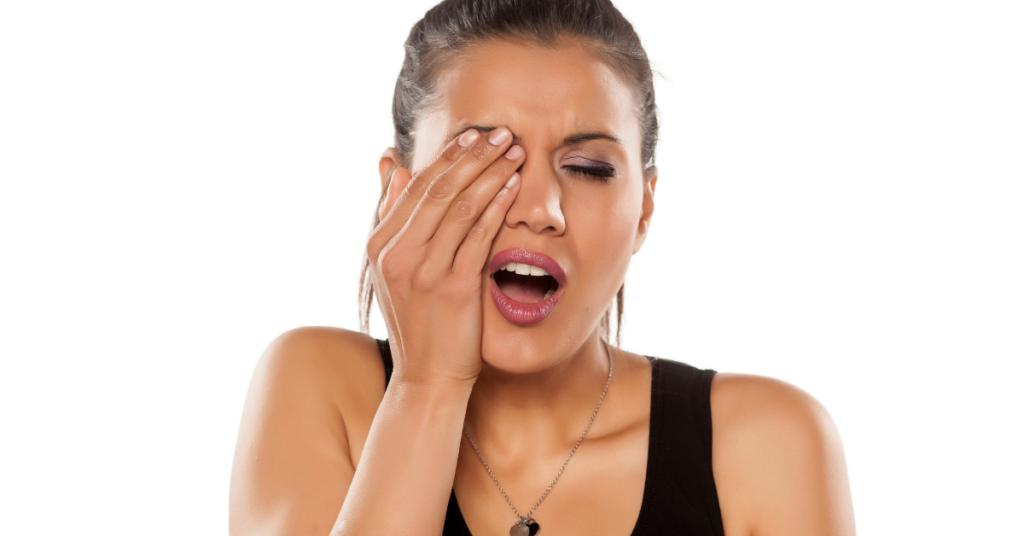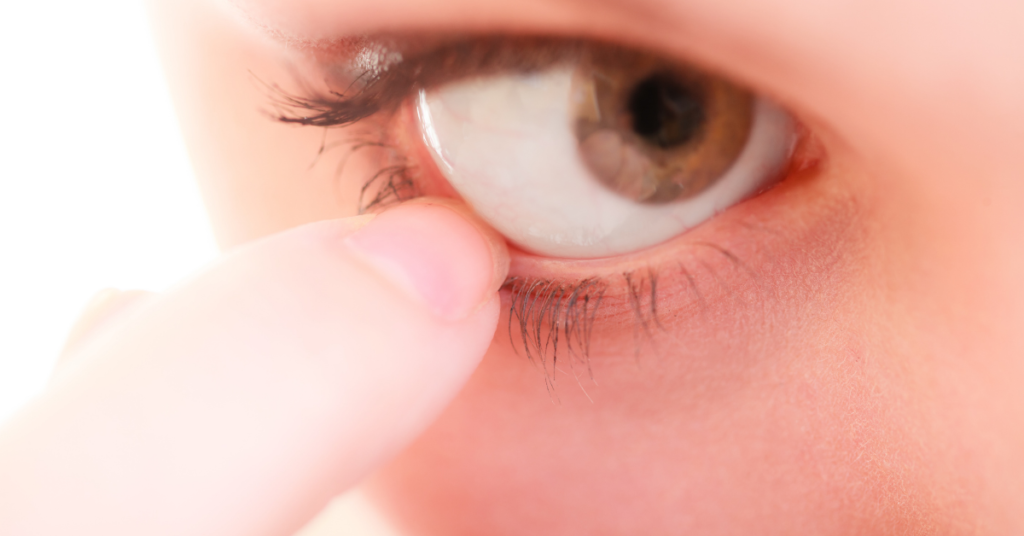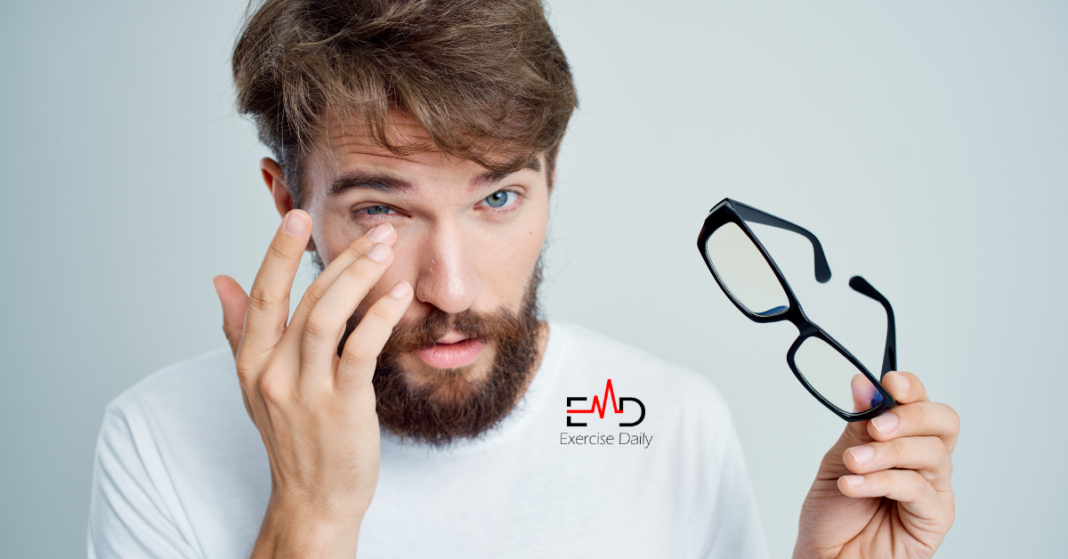Exercise Daily – An ingrown eyelash is one that develops in the incorrect direction, that is, towards the eyes. Trichiasis is the medical name for this type of growth.
An ingrown eyelash may come into contact with the eyeball, causing irritation to the eyeball and surrounding skin.
Pain, redness, watery eyes, and corneal damage are all possible side effects of this course of action. Injuries, inflammation, and certain eye diseases can all contribute to trichiasis.
It is possible for eyelashes to become entangled in the skin and grow inward, just like other ingrown hairs.
As a result, symptoms that are similar to those of eye diseases such as styes, which are often caused by bacterial infection, might occur.
When an issue occurs, it is critical that it is appropriately identified and treated. If you feel your eyes hurting in the morning, then it can be a cause.
In this post, we will discuss the causes, symptoms, and remedies of an ingrown eyelash.
What Exactly is Trichiasis and Ingrown Eyelash?
The majority of ingrown hairs become entrapped behind the skin, resulting in a painful lump.
The hair follicle, which is a sheath of cells that surrounds the hair follicle, may get infected with bacteria. When an eyelash is involved, all of this can be extremely and terribly painful.
Trichiasis, on the other hand, is a little different. The eyelash develops outside of the skin but in the opposite direction of its natural growth.
The eyelashes on the top eyelids often grow forward toward the forehead, allowing them to capture debris and protect the eye from injury or infection. Trichiasis is a condition in which the eyelashes curl downward and inward toward the eye.
Trichiasis can even cause the lashes to come into contact with the eye, creating discomfort. It is possible for someone to get the sensation that something is in their eye.
Generally speaking, trichiasis is more frequent in adults than in children, but it can affect anybody at any age.
Cause of Ingrown Eyelash

While trichiasis may be caused by a variety of factors, the following are the most common:
Injury
It is possible for eyelashes to grow in a different direction as a result of scar tissue that forms after an injury. This can also occur as a result of eye surgery.
Developmental Changes
As a kid grows, the form of his or her eyelashes and hair follicles may momentarily shift. Any trichiasis that occurs, as a result, is often only transitory.
Blepharitis
Inflammation and irritation of the lower eyelids can result in chronic blepharitis, which can cause the skin to peel and appear red, as well as accumulate mucus and germs on the eyelids themselves.
Entropion
This disease causes the eyelid to curl inward, which might result in trichiasis. Entropion can be caused by a variety of factors, including age-related muscle and tissue weakening, infection, and injury.
Herpes of the eye
Herpes can affect the eye and cause damage to the eyelid, resulting in trichiasis.
Trachoma
It is possible to go blind as a result of trachoma, a serious eyelid infection that can affect the eyelashes. Trachoma is more frequent in poor nations than in developed countries.
Trichiasis is caused by chronic diseases that affect the eyelashes or mucous membranes, such as Stevens-Johnson syndrome, in rare situations.
Symptoms of Ingrown Eyelash
Trichiasis can manifest itself in a few eyelashes at first, but it can progress to infect many or all of the eyelashes over time.
For the most part, patients suffering from trichiasis are aware of a specific location where many or all of their lashes are developing in the wrong direction.
Changes in eyelash development can irritate the eye and cause a variety of additional symptoms, including the following:
- A feeling that something is in the eye
- The appearance of redness around the eyes
- Increased sensitivity to light
- Teary eyes
- Itching or sore eyes
Leaving trichiasis untreated can result in eye injury, such as scratching the cornea and exposing the region to infection.
When trichiasis is caused by another eye problem, extra symptoms may develop themselves. Blepharitis is a disease that frequently develops in conjunction with trichiasis.
Eyelid blepharitis is characterized by inflammation of the eyelid edge, and a person suffering from the condition may notice that the skin of their eyelid peels, becomes red and puffy, accumulates mucus, or becomes abnormally sensitive.
How to Identify An Ingrown Eyelash?

The sensation of having your eyelashes in your eye might be fluttery, gritty, or harsh and stinging. It is possible that you may not feel the eyelash come out, and it is also possible that it will not be the consequence of rubbing your eyes.
By standing in front of a mirror, keeping your eye open, and moving your eye from side to side, you may determine if what’s in your eye is an eyelash.
It is possible that the eyelash will become visible, but this is not guaranteed. If you detect or believe that you have an eyelash in your eye, follow the steps below to remove it from your eye.
How to Remove An Ingrown Eyelash?
An ingrown eyelash is usually removed by a doctor when only a few of the lashes are affected. Then they may be able to regenerate in the proper direction.
When it comes to relieving the strain and eliminating the problem, eyelash removal is really essential.
Plucking
The removal of an eyelash is not a major hassle. You may either pluck it yourself or have someone else do it for you.
However, having someone else pluck the eyelash is preferable. You’ll most likely need to consult an ophthalmologist for treatment and a more permanent solution if you want to avoid future issues.
Surgery
When removing an eyelash, your specialist will grasp the lash with forceps or pliers and carefully pull it out of the socket. During the healing process of your eye, you’ll require eye drops to alleviate the discomfort.
Eyelid Surgery or Ablation Surgery
Removal surgery involves the use of radio waves or laser waves to penetrate the root of the eyelash, which is coordinated by a trained professional.
This will allow the eyelash to be released and should be beneficial in the case of a recurring problem.
Cryosurgery
It is a form of surgery that includes the use of intense cold to aberrant tissues, such as tumors, in order to eliminate them.
Cryosurgery, also known as cryotherapy, is a method that is similar to the one used by surgeons to remove warts by spraying them with liquid nitrogen.
Electrolysis
Another sort of hair removal procedure that dermatologists use is electrolysis. It is accomplished by the use of an epilator device that is inserted into the skin.
It works by using shortwave radio frequencies in the hair follicles to prevent new hair growth. This harms your hair follicles, preventing new hair development and causing existing hairs to fall out as a result.
6 Home Remedies for Ingrown Eyelash

Aloe
Aloe vera helps to reduce inflammation in the eyelids and alleviate discomfort caused by the condition. It is possible that this will aid in the natural release of the lash. However, this therapy does not eliminate the underlying cause of the issue.
To apply this technique, dab a tiny quantity of aloe vera on the afflicted eyelid 2 to 3 times each day, depending on how severe the irritation is.
Coconut Oil
Coconut oil, like aloe vera, has no impact on the ingrown eyelash and cannot be used to eliminate it. However, it can give temporary comfort and may even aid in the dissolution of blockages in the follicle that are preventing the lash from falling out.
Simply apply a tiny amount of coconut oil to the lash line twice a day to achieve the desired results.
Honey
Honey has anti-inflammatory and antibacterial properties that are natural. As a result, it can help to decrease inflammation and prevent infection associated with an ingrown eyelash if you have one. Warm water should have a tiny amount of honey added to it.
Place the mixture on a warm towel and apply the compress to the affected eye area.
Cucumber
As an added bonus, cucumber is good for decreasing inflammation and calming discomfort surrounding an ingrown eyelash.
You can prepare cucumber by simply slicing a fresh cucumber into many thin slices. Slice the cucumbers and place one on each afflicted eye.
Compress
The warm compress treatment is one of the most effective and safest elimination procedures that you can use at home.
This technique aids in the reduction of irritation and pain associated with an ingrown lash. It also improves healthy blood flow and aids in the speedy recovery of wounds.
Making a warm compress with a clean cloth and applying it to the afflicted region for 10 to 15 minutes twice a day is all that you need to do.
Pressure
It may be sufficient to apply pressure to the affected region in order to eliminate the ingrown eyelash for some people.
In this situation, mild pressure on each side of the hair, similar to how you would apply pressure to a plugged pore or pimple, would be applied.
It is possible that applying pressure would force the hair to shift and lift out of the follicle, allowing you to remove it fully. You should apply warm compresses after this therapy to aid in the healing process and to prevent future problems from arising.
8 Simple Steps to Remove Eyelash from Your Eye (Not Ingrown)
- Before you begin, properly wash your hands with soap and water and pat them dry with a towel to avoid spreading germs. If you have contact lenses in your eyes, take them out. If your eye is already inflamed, you should not risk introducing bacteria into the eye by touching it.
- Gently tug at the skin over your brow bone and the skin below your eye while looking into the mirror. For a little moment, examine your eyes closely to see if you can detect an eyelash floating about in your pupil.
- Take a deep breath and blink many times to check whether your natural tears will wash away the eyelash without rubbing it.
- The upper eyelid should be gently pulled forward and over toward the lower lid if the ingrown eyelash seems to be behind the upper eyelid. Start by looking above, then to your left, then to your right, and finally down. Repeat this procedure several times in order to try to bring the eyelash toward the center of your pupil.
- If you see one eyelash sliding down toward or beneath your lower eyelid, try gently grabbing it with a moist cotton swab to see if it can be gently snatched. This should only be done if the lash is on the white portion of the eye or on the eyelid.
- To flush the eyelash out, use artificial tears or saline solution.
- If none of the methods listed above have been successful, fill a small juice cup halfway with lukewarm, filtered water and set it aside. Try rinsing the eyelash out of your eye with the cup.
- Consider using the shower as the last option, with a moderate stream of water directed toward your eye.
In Case of Kids
Please don’t try to remove an ingrown eyelash that has been lodged in the pupil of your child’s eye with your fingernails or with any other sharp instrument.
Keep your child’s eye open while rinsing it with saline solution or artificial tear eye drops. If the instructions above don’t work, instruct them to look from side to side and up and down while you rinse it.
If these options are not accessible, a moderate trickle of clean, lukewarm, or chilly water can be suitable to use. You may also try rubbing the corner of your eye with a damp cotton swab to see if it helps to remove it.
In the event that an eyelash stuck in your eye or in the eye of a kid for more than an hour, you may need to seek medical attention.
It is possible that repeated attempts to remove an eyelash from an eye can scrape and irritate the cornea, increasing the likelihood of developing an eye infection.
Ingrown Eyelash – FAQs
Will an ingrown eyelash fix itself?
No, in most cases, ingrown eyelash doesn’t fix itself. When only a few eyelashes are deformed or ingrown, a doctor would generally remove them as a preventative measure.
It’s possible that they’ll regrow in the proper direction. It is also critical to address the underlying source of the problem.
Do I have a stye or an ingrown eyelash?
The symptoms of an ingrown eyelash are quite similar to those of a stye, which is a skin infection. Patients may detect a raised lump in their eye or have the impression that something is stuck in their eye that they are unable to dislodge.
The presence of ingrown eyelashes can also produce redness around the eye, which can become irritating and unpleasant if left untreated for a long period of time.
How do you treat an infected eyelash follicle?
You can easily treat infections with Antibiotics. Other possible treatments include warm compresses and ice packs. In-office treatments such as puncturing bumps and emptying styes are common.
Can you pull the eyelash out of a stye?
In the case of a stye, it is critical not to squeeze or poke the stye, since this might result in scarring of the eyelid or the transfer of infection to other parts of the body.
You should not pluck your eyelashes to get rid of a stye because this might lead to additional issues.
How do you get an eyelash out of your upper eyelid?
Gently pull forward the upper eyelid and over toward the lower lid of the lash as it seems to be behind the upper eyelid.
Look up, then to your left, then to your right, and finally down. It’s a circular motion. Repeat this procedure several times in order to try to bring the eyelash toward the center of your pupil.




